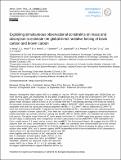| dc.contributor.author | Schwarz, J. P. | |
| dc.contributor.author | Spackman, J. R. | |
| dc.contributor.author | Perring, A. E. | |
| dc.contributor.author | Coe, H. | |
| dc.contributor.author | Liu, D. | |
| dc.contributor.author | Clarke, A. D. | |
| dc.contributor.author | Wang, Xuan | |
| dc.contributor.author | Heald, Colette L. | |
| dc.contributor.author | Ridley, David Andrew | |
| dc.date.accessioned | 2014-12-24T17:21:56Z | |
| dc.date.available | 2014-12-24T17:21:56Z | |
| dc.date.issued | 2014-10 | |
| dc.date.submitted | 2014-09 | |
| dc.identifier.issn | 1680-7324 | |
| dc.identifier.issn | 1680-7316 | |
| dc.identifier.uri | http://hdl.handle.net/1721.1/92506 | |
| dc.description.abstract | Atmospheric black carbon (BC) is a leading climate warming agent, yet uncertainties on the global direct radiative forcing (DRF) remain large. Here we expand a global model simulation (GEOS-Chem) of BC to include the absorption enhancement associated with BC coating and separately treat both the aging and physical properties of fossil-fuel and biomass-burning BC. In addition we develop a global simulation of brown carbon (BrC) from both secondary (aromatic) and primary (biomass burning and biofuel) sources. The global mean lifetime of BC in this simulation (4.4 days) is substantially lower compared to the AeroCom I model means (7.3 days), and as a result, this model captures both the mass concentrations measured in near-source airborne field campaigns (ARCTAS, EUCAARI) and surface sites within 30%, and in remote regions (HIPPO) within a factor of 2. We show that the new BC optical properties together with the inclusion of BrC reduces the model bias in absorption aerosol optical depth (AAOD) at multiple wavelengths by more than 50% at AERONET sites worldwide. However our improved model still underestimates AAOD by a factor of 1.4 to 2.8 regionally, with the largest underestimates in regions influenced by fire. Using the RRTMG model integrated with GEOS-Chem we estimate that the all-sky top-of-atmosphere DRF of BC is +0.13 Wm[superscript −2] (0.08 Wm[superscript −2] from anthropogenic sources and 0.05 Wm[superscript −2] from biomass burning). If we scale our model to match AERONET AAOD observations we estimate the DRF of BC is +0.21 Wm[superscript −2], with an additional +0.11 Wm[superscript −2] of warming from BrC. Uncertainties in size, optical properties, observations, and emissions suggest an overall uncertainty in BC DRF of −80%/+140%. Our estimates are at the lower end of the 0.2–1.0 Wm[superscript −2] range from previous studies, and substantially less than the +0.6 Wm[superscript −2] DRF estimated in the IPCC 5th Assessment Report. We suggest that the DRF of BC has previously been overestimated due to the overestimation of the BC lifetime (including the effect on the vertical profile) and the incorrect attribution of BrC absorption to BC. | en_US |
| dc.description.sponsorship | United States. Environmental Protection Agency. Office of Research and Development National Center for Environmental Research Science to Achieve Results (STAR) Program (Grant RD-83503301) | en_US |
| dc.language.iso | en_US | |
| dc.publisher | Copernicus GmbH | en_US |
| dc.relation.isversionof | http://dx.doi.org/10.5194/acp-14-10989-2014 | en_US |
| dc.rights | Creative Commons Attribution | en_US |
| dc.rights.uri | http://creativecommons.org/licenses/by/3.0/ | en_US |
| dc.source | Copernicus Publications | en_US |
| dc.title | Exploiting simultaneous observational constraints on mass and absorption to estimate the global direct radiative forcing of black carbon and brown carbon | en_US |
| dc.type | Article | en_US |
| dc.identifier.citation | Wang, X., C. L. Heald, D. A. Ridley, J. P. Schwarz, J. R. Spackman, A. E. Perring, H. Coe, D. Liu, and A. D. Clarke. “Exploiting Simultaneous Observational Constraints on Mass and Absorption to Estimate the Global Direct Radiative Forcing of Black Carbon and Brown Carbon.” Atmospheric Chemistry and Physics 14, no. 20 (2014): 10989–11010. | en_US |
| dc.contributor.department | Massachusetts Institute of Technology. Department of Civil and Environmental Engineering | en_US |
| dc.contributor.department | Massachusetts Institute of Technology. Department of Earth, Atmospheric, and Planetary Sciences | en_US |
| dc.contributor.mitauthor | Wang, Xuan | en_US |
| dc.contributor.mitauthor | Heald, Colette L. | en_US |
| dc.contributor.mitauthor | Ridley, David Andrew | en_US |
| dc.relation.journal | Atmospheric Chemistry and Physics | en_US |
| dc.eprint.version | Final published version | en_US |
| dc.type.uri | http://purl.org/eprint/type/JournalArticle | en_US |
| eprint.status | http://purl.org/eprint/status/PeerReviewed | en_US |
| dspace.orderedauthors | Wang, X.; Heald, C. L.; Ridley, D. A.; Schwarz, J. P.; Spackman, J. R.; Perring, A. E.; Coe, H.; Liu, D.; Clarke, A. D. | en_US |
| dc.identifier.orcid | https://orcid.org/0000-0003-2894-5738 | |
| dc.identifier.orcid | https://orcid.org/0000-0003-3890-0197 | |
| dc.identifier.orcid | https://orcid.org/0000-0002-8532-5773 | |
| mit.license | PUBLISHER_CC | en_US |
| mit.metadata.status | Complete | |
